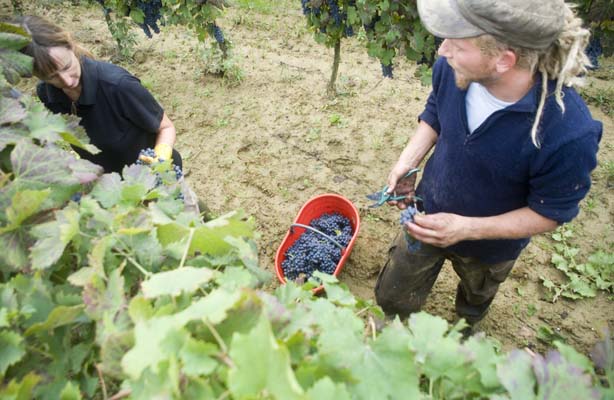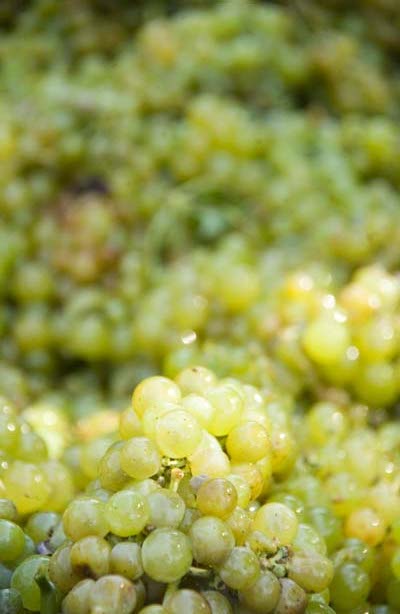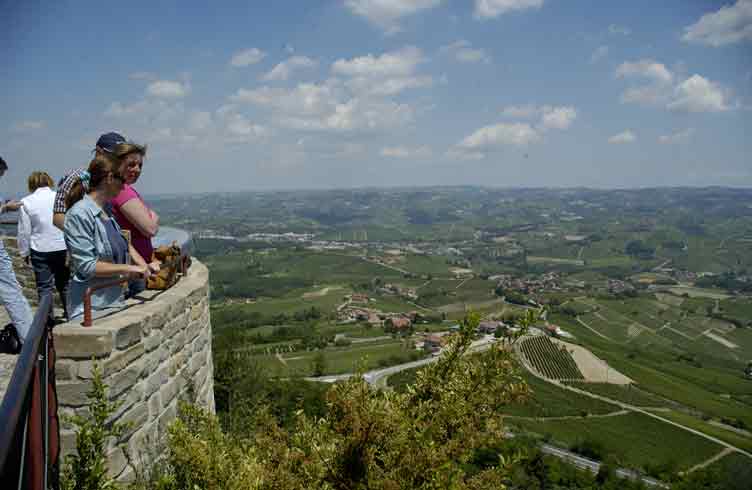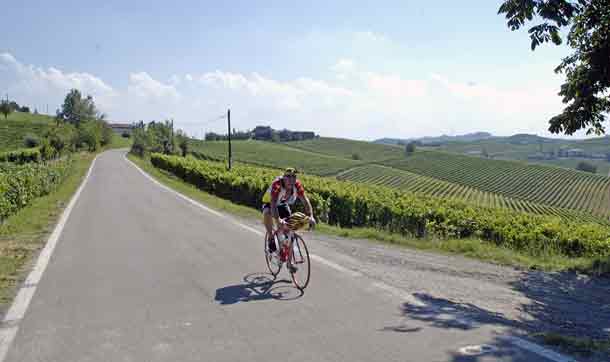Piedmont's soil offers rich black cherry reds, lighter-bodied reds, and some of the most refreshing whites in both still and sparkling. The region is amazing in both its variety and quality of wines. It is definitely one of the best regions in which to base yourself if you want to tour beautiful wine areas. Moving around in the protective inner ring created by the
 |
 |
 |
|
picking our moscato bunches
|
Adriano, Simona & Sorin helping to pick our barbera bunches
|
Ingrid & Raphael picking our barbera bunches
|
 |
 |
 |
|
freshly picked moscato bunches (12 September 2006)
|
Working in the cantina - remontage of the barbera "must"
|
freshly picked barbera bunches (1 October 2006)
|
A Selection of Astesana Wines
Astesana, the ancient land around
In total there are 12 DOC and DOCG wines from Astesana and when the various types and sub-denominations are factored in, there are over 47 types of wording possible on the wine labels. It is no wonder that people can get confused about what to buy. The descriptions provided in the wine page of this site will hopefully give you a guiding hand in understanding what is available. In the Astesana zone, Barbera is king and many of the best wines are from this area. It is in
The Astesana Wine Road
The wine road, also known as Astesana, has eight protected routes running along peaceful secondary roads with inspiring views. The names of these routes are:
Colli Astiane, Bricchi, Lauretum, Canelli and the Land of Gold, Colline del Nizza, Castles, Langa Astigiana and the Colli di Alferi. Wine tours.
The wine communes encompassed by the Castles route include Bruno and Castelnuovo Belbo which is where Vecchio Podera Santa Cristiana’s wine is made. It is a delightful route that has a particularly high number of castles and old towers. It is in fact the area with the greatest density of historic buildings in

pictures of Our vineyards
We are happy to provide information to our guests on any of the eight wine routes mentioned. All are possible by car, many are great bike routes and some are even possible on foot. In addition we can arrange tastings and advice on cantinas, restaurants and local speciality shops. Please contact us to discuss your requirements. Meanwhile watch this space for information on special wine events and organised tasting programmes
Piedmontese vine growing occurs predominately in the two large areas known as the Lange and Monferrato. The Langhe is a region full of splendid, hills, bound by the Tanaro and Bormida valleys, and the Ligurian Alps. The hills, which geographically speaking make up an extension of the Northern Apennines into
LATEST NEWS..Piano Piano II was bottled late July and is available to order from 1 September |
see more pictures of Our vineyards
The Monferrato vine growing area is sub-divided into two distinct areas. Geographically the Villafranca d'Asti valley, the Borbore stream and the lower part of the Tanaro valley divide the northern Lower Monferrato from the
A table below provides information to help you match the major appellations of the region with the grape
|
Type |
Wine |
Grapes Used |
|
Red |
Barolo |
Nebbiolo |
|
Red |
Barbaresco |
Nebbiolo |
|
Red |
Barbera |
Barbera |
|
Red |
Dolcetto |
Dolcetto |
|
Red |
Bonarda |
Bonarda [traditionally called Croatina] |
|
Red |
Ghemme |
Nebbiolo |
|
Red |
Gattinara |
Nebbiolo or Bonarda |
|
Red Effervescent |
Brachetto |
Brachetto |
|
Red |
Grignolino |
Grignolina |
|
White effervescent |
Moscato d’Asti |
Moscato |
|
White |
Gavi or Cortese |
Cortese |
|
White |
Roero Arneis |
Arneis |
|
White Sparkling |
Spumante |
Moscato |
On The Wine Trail
When you exit the autostrada or leave the train station at
A Selection of Astesana Wines.
In total there are 12 DOC and DOCG wines from Astesana and when the various types and sub-denominations are factored in there are over 47 types of wording possible on the wine labels. It is no wonder that people can get confused about what to buy. The descriptions provided below are not intended as an exhaustive list of all wines available but hopefully will give you a guiding hand with your selection.
Vini Rossi the Red Wines
Barbera - The Barbera grape occupies nearly 35% of
Piedmont’s provinces of
Essentially you have the choice of three styles of Barbera. Firstly the stainless steel aged Barbera that produces a fresher, fruity wine. Thanks to their plentiful anthocyans and their reduced tannins, in skilled hands Barbera grapes can produce splendid easy to drink medium bodied reds that are affordable and approachable when young. Secondly the barrique aged Barbera’s that are grand and powerful. Giacomo Bologna changed everything for Barbera when he released his Bricco dell’Uccellone in the early eighties. Selecting grapes from the best vineyard and aging them in new French barriques his results started a revolution in Piedmont wine producing circles. Today’s producers are now using the barrel to soften out their acidic Barbera wines. Barrique techniques combined with lower yields and old vines are producing wines that are big and soft. The 11% alcohol levels of the supermarket brands can raise to 14% or higher in some new style Barbera wines. The best selections and the ‘Superiore’ version grace any table and are perfect with top quality meat, game and mature cheeses. To obtain a ‘Superiore' denomination requires adherence to strict disciplinary regulations including careful selection of the grapes and refining in the cellar for a minimum of 1 year. If stored properly these wines can be appreciated even after 10 years in the bottle. The third type of Barbera comes from producers who are blending Nebbiolo and Barbera grapes. These super-Piemonte wines fall under the Langhe Rosso DOC denomination and tend to be around 60% Barbera and 40% Nebbiolo. They represent Piedmonts answer to super – Tuscans. They can cost as much (if not more) than Barolo and Barbaresco.
In the Astensana zone [ancient wine roads] Barbera is king and in
How you feel about strong oak flavours in wine;
How much you want to spend;
How well you can store the wine;
Whether you want to invest for the future and lie the wine down;
What you are going to drink it with;
Since 1970 Barbera d’Asti DOC and Barbera del Monferrato DOC have been produced from perfect soils, the best exposure of hills and a great microclimate.
Barbera d’Asti is one of the most important wines of Astensana. Linked with ancient farming traditions, the grapes are harvested quite late [early October]. This wine is sold in various forms and is increasingly becoming the choice of knowledgeable consumers. Although the ‘Barbera’ label is not yet well known outside of
Recommended tasting temperature for Barbera d’Asti wine is normally 18 – 20 degrees centigrade and you should open the bottle at least two hours before drinking.
Barbera Del Monferrato – This area claims the Barbera grape as its own. A dry, vaguely semi-sweet, full to medium bodied wine usually effervescent or sparkling that leaves the palate pleasantly velvety. It is a ruby red colour of varying intensity. Good vintages are aged up to four years. It pairs well with all meats including chicken and can complement spicy cheeses when aged. Its light froth that results from natural fermentation makes it a good accompaniment with beef stews. Recommended tasting temperature is 18 – 20 degrees centigrade and you should open the bottle at least two hours before drinking.
Piemonte Bonarda – This ruby red wine made from a traditional Piedmontese grape that has been around since the 16th century. It is best cultivated in very exposed sites, which perhaps explains why it is currently only grown in small amounts in this region. The Bonarda grape however has been exported to other parts of the world and is used increasingly in blended wines. This is a full bodied wine with a long lasting bouquet and a fragrance that comes with a subtle hint of almond. It is slightly tannic but with less acidity than its near neighbour, the Barbera grape and it is more rounded and softer. A wine with style and character that is not available in large quantities so is an excellent choice for those who do not shrink from being more individual with their wine collections. It pairs well with hors d’oeuvres, cold meats, soups, red meats and is excellent with fresh or mild cheese. Recommended tasting temperature is 18 – 20 Degrees centigrade.
Piemonte Brachetto – This is the red cousin of the white Moscato grape. A great Piedmontese desert wine whose production is limited but its scarce quantity is compensated by its excellent quality. It comes from 18 communes in the
Grignolino - is one of the great aristocratic wines of
Vini Bianchi the White Wines
Asti Spumante possibly one of the best known sweet white sparkling wines of this region made from Moscato grapes. Millions of bottles are exported from
Moscato D’Asti This aromatic wine is not so well known outside
Cortese Alto Monferrato – One of the most important of the dry white wines produced in this area. Despite the Cortese grape being around in the 18th century, this wine does not enjoy the same reputation as the reds and the Moscato's. It is however an easy drinking wine that is delicious with the right food. The grape is only grown in very hilly areas with appropriate slopes and exposures. It is bright straw yellow in colour, and can go towards green. It comes in dry still, dry frizante and dry sparkling varieties. Normally it has an aromatic slightly acidic bite. It is drunk quite young after 1-2 years of aging standing. It pairs well with hors d’oeuvres, light fish, pasta, risotto, vegetable dishes and Bruschetta. Recommended tasting temperature is 8 – 10 degrees centigrade.
 |
 |
 |
|
view of house & alps from our vineyard
|
Moscato apartment
|
house & vineyards
|






